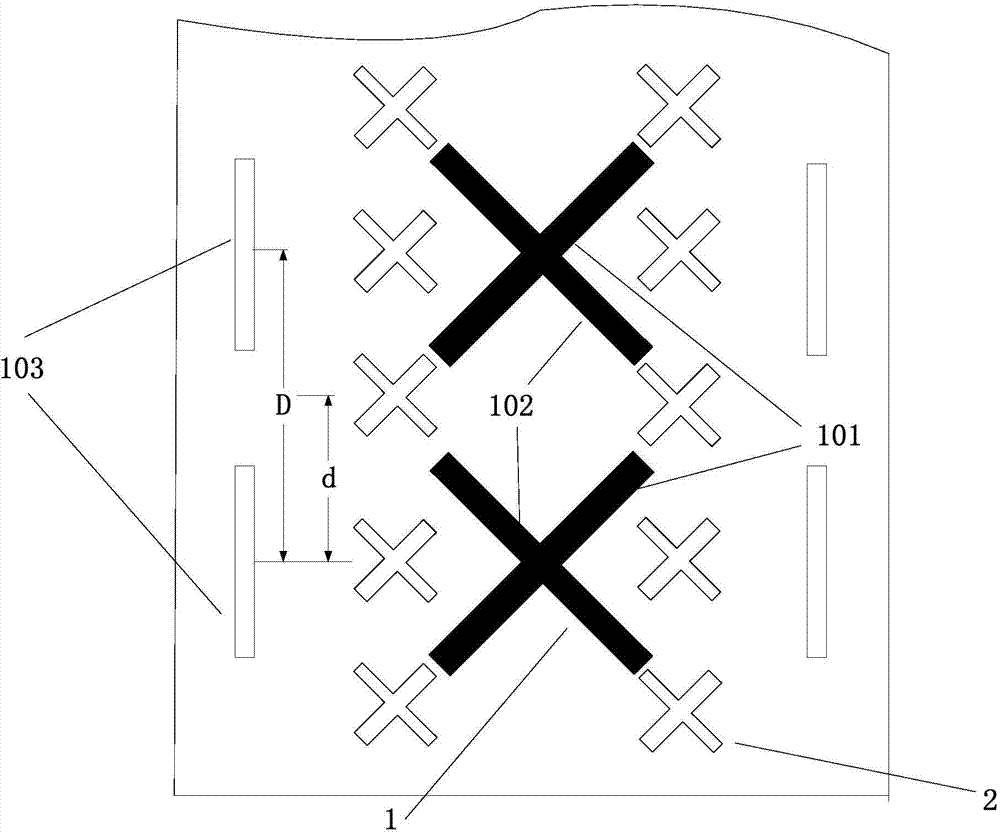Ultra-wide frequency band multi-band array antenna
An array antenna and ultra-wideband technology, which is applied in the field of ultra-wideband multi-band array antennas, can solve the problems of increasing cost, production difficulty, and reducing antenna gain, so as to reduce operation and maintenance costs, reduce the number of antennas, and have a simple and compact structure Effect
- Summary
- Abstract
- Description
- Claims
- Application Information
AI Technical Summary
Problems solved by technology
Method used
Image
Examples
Embodiment 1
[0032] Such as Figure 2 to Figure 4 As shown, an ultra-wideband three-band array antenna provided by an embodiment of the present invention includes a metal reflector, and a low-frequency radiating unit 1 working in a lower frequency band and a high-frequency radiation unit 1 working in a higher frequency band installed on the metal reflector. Frequency Radiation Unit 2. Preferably, the low-frequency radiation unit 1 works in the frequency range of 694-960 MHz, and the high-frequency radiation unit 2 works in the frequency range of 1710-2690 MHz.
[0033] The low-frequency radiating unit 1 includes two low-frequency vibrators that are polarized at ±45 degrees and are installed orthogonally to each other, namely, the positively polarized low-frequency vibrator 101 and the negatively polarized low-frequency vibrator 102. 45-degree polarized far-field radiation pattern. Centers of multiple low-frequency radiation units 1 are arranged at equal intervals along the first referenc...
Embodiment 2
[0042] In the multi-band array antenna, reducing the overlapping portion of the orthographic projections of the antennas of each frequency band on the metal reflector, or even making them non-overlapping, can effectively reduce the electrical interference between the antennas of each frequency band. However, in Embodiment 1, if the orthographic projections of the low-frequency radiation unit 1 and the high-frequency radiation unit 2 are to be avoided from overlapping on the metal reflector, the lengths of the two low-frequency oscillators in the low-frequency radiation unit 1 must be limited to prevent the low-frequency oscillators from touching When encountering a high-frequency vibrator, this limits the radiation characteristics of the low-frequency radiation unit 1 to a certain extent.
[0043] Such as Figure 5 and Figure 6 As shown, the embodiment of the present invention is improved on the basis of Embodiment 1. Specifically, the end of the low-frequency vibrator also ...
Embodiment 3
[0047] Such as Figure 7 As shown, the embodiment of the present invention is changed on the basis of the second embodiment, and an ultra-wideband five-band array antenna is provided. Specifically, the multiple high-frequency radiation units in each column of high-frequency arrays in the embodiment of the present invention are divided into two parts from the middle, respectively belonging to two mutually independent high-frequency systems. In other words, there are four mutually independent high-frequency systems in the embodiment of the present invention, which are respectively Figure 7 The part selected by the four rectangular frames in , together with another low-frequency system, constitutes a five-band array antenna in which one low-frequency system and four high-frequency systems coexist.
[0048] Other features in this embodiment of the present invention are the same as those in Embodiment 2, so details will not be repeated here.
PUM
 Login to View More
Login to View More Abstract
Description
Claims
Application Information
 Login to View More
Login to View More - R&D
- Intellectual Property
- Life Sciences
- Materials
- Tech Scout
- Unparalleled Data Quality
- Higher Quality Content
- 60% Fewer Hallucinations
Browse by: Latest US Patents, China's latest patents, Technical Efficacy Thesaurus, Application Domain, Technology Topic, Popular Technical Reports.
© 2025 PatSnap. All rights reserved.Legal|Privacy policy|Modern Slavery Act Transparency Statement|Sitemap|About US| Contact US: help@patsnap.com



